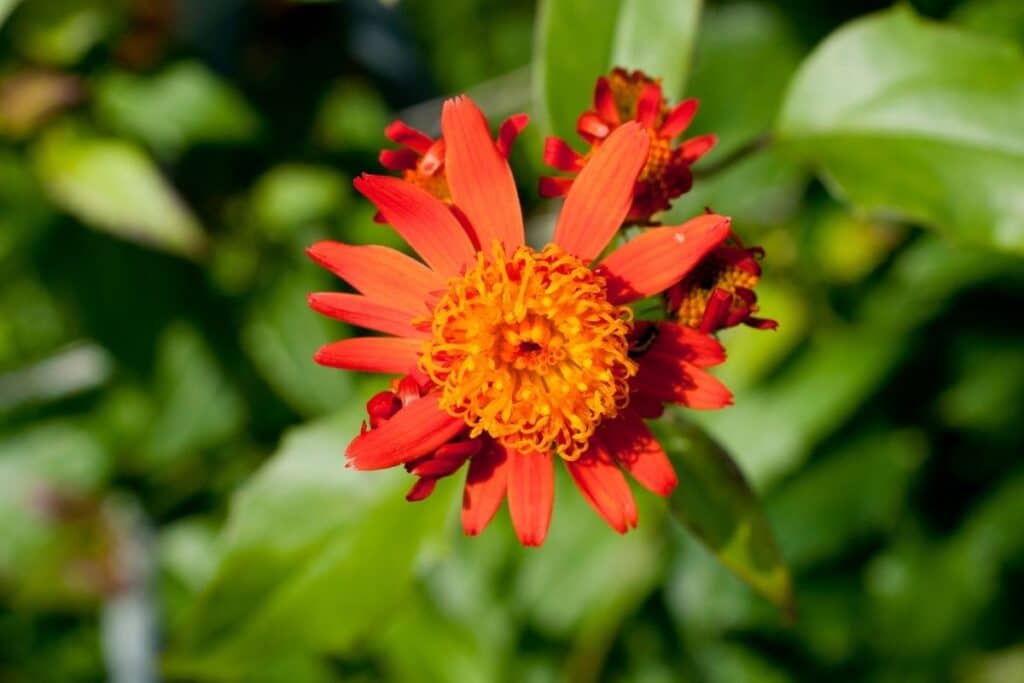Who does not like having a mass of attention-grabbing flowers that are easy to grow? Those characteristics check out with the Mexican Flame Vine. The contrast of the clusters of orange or red small flowers to its broad arrow-shaped leaves makes it a flowering vine suitable for a beautiful landscape.
As long as you live in an area with warm weather, ideally USDA hardiness zones 8 through 10, you can grow this gorgeous nectar plant that attract monarch butterflies and other pollinators, like gulf fritillaries.
This vine is a beneficial addition to a butterfly garden because it serves as a flower buffet for them! Not to mention, with its golden centers and beautiful orange flowers, it’s the perfect twining vine for any garden. It offers undeniable beauty!
Continue reading to know more about how to grow and care for the Mexican flame vine plant!
Botanical Information for Mexican Flame Vine
The Mexican flame vine, Mexican flame, or flame vine is known in the scientific community as the Senecio confusus, Pseudogynoxys chenopodioides, or Pseudogynoxys confusus.
For the most part, Pseudogynoxys chenopodioides is the name most often used for plants in the Mexican flame vine family, though Senecio confusus is a close second.
It belongs under the Asteraceae family, also called Compositae, which is the same family as famous ornamental cut flowers, asters, daisies, and sunflowers. Having said this, the Mexican flame vine can go head-to-head to the commonly loved flowers in terms of beauty.
Mexican Flame Vines’ Spatial Distribution
Despite being a native of Mexico, the Mexican flame vine is winter hardy. It thrives in USDA zones 9 through 10, but it also grows in some areas in zone 8 with the help of mulching.
Growth Habits of Mexican Flame Vines
As a fast-growing vine, this plant easily covers areas in a short span. It reaches 3 to 6 feet in width and 6 to 12 feet in height. Although, the vertical distance it can cover will also vary depending on the existing structures for anchorage.
The evergreen vine is an aggressive grower, but as it matures tends to grow slower. Despite this decreased growth rate, it still stays prolific and blooms beautiful flowers that attract butterflies and bees. It also is preferred to be used as an annual plant to maintain vigor.
Leaves of Mexican Flame Vines
The leaves resemble an arrowhead due to its pointed triangular shape attached to a smooth stem. Moreover, its broad green leaves give the vine a rough texture due to being 4 inches long and having serrated leaf margins.
Flowers
As a close relative of famous ornamental flowering plants, such as marigold, aster, and sunflower, this vine produces flowers that add color and beauty to the landscape. Like species under the same family, its flowers are showy, especially from June to October or spring until fall.
The flowers start with an orange hue but progress to a red hue. The flowers create more impact due to it having dense appearance. They are grown in clusters, with each flower less than an inch in diameter.
Fruit and Seeds
After flowering, this vine develops seed puffs like a dandelion. This helps the vine reproduce easily, and the seeds are dispersed commonly through water and wind. When humans often go to a landscape with the Mexican flame vine’s seed puffs, there are instances where some seeds latch onto clothes.
Grow and Care Tips for Mexican Flame Vines
Here are a few tips to help you grow and care for your Mexican Flame Vine plant.
Sun Requirement
The flame vine loves to be exposed under the full sun. Even more so when it is in its flowering stage, wherein a minimum of 6 consecutive hours for sunlight exposure is beneficial for the flower production and pigmentation of the plant.
Even if the vine is sun-loving, it may thrive under partial shade but may become less prolific during bloom seasons.
Water Requirement
The best way to water this vine is by doing it frequently in average amounts of water. Sprinklers and drip irrigation systems will do wonders for the plant’s growth. Also, using these will avoid overwatering.
The vine often benefits from slightly dry soil, but not the point of wilting despite being tolerant to drought when established.
Remember that watering schedules should be adjusted as the climate changes. For instance, more frequent watering is done during hot summer days. On the other hand, less frequent watering is recommended when the climate is cold and rainy.
Temperature and Humidity
Due to its native habitat, the Mexican flame vine plant is biased to a warm environment. However, it can also thrive in colder climates with the help of mulching. Mulching keeps the soil temperature warmer to avoid root damage.
Soil Requirement
The optimal soil for this vine is the one having high organic matter content, good drainage, and medium water holding capacity. It is a versatile plant that can grow almost anywhere and can expand rapidly.
Keeping this in mind, remember to allot adequate planting distance to give the Mexican flame room to grow without invading other spaces. The planting distance will vary depending on the landscape function the vine will serve.
Fertilizer Requirement
If the planting medium already has high organic matter, application of fertilizer is not necessary. The regular annual or bi-annual application of complete fertilizer may be done to revitalize the soil in the garden. Although, remember to not put nitrogen fertilizers during the flowering phases of the plant as this will promote foliage production and inhibit the formation of blooms.
Maintenance Activities
As the vine matures, the blooms tend to grow more on the tips of the shoots. This will make the top of the plant concentrated with flowers, and the body is mostly foliage.
To avoid this from happening, cutting back the vine before summer is recommended. In doing so, the production of new shoots and flowering will be dispersed.
Aside from cutting back, regular pruning after flowering will benefit the overall plant health. Along with this should be the removal of dead and damaged plant parts. The vine can tolerate frequent pruning thanks to its vast growth and development. This is a beneficial characteristic for vines to be trained.
Propagation
Although planting seeds is a viable option, the best way to propagate the Mexican flame vine is with stem cuttings. Collect stem cuttings that are not too old nor too young, make sure that it is still actively growing, which may be near the tips. After gathering the stem cuttings, they may be placed in a clear container with water to develop roots.
The container may or may not be clear, but the clear ones will allow the grower to see if the cuttings are ready to be planted in the soil.
In transplanting, follow the soil requirements mentioned above. Also, they may be planted in pots, hanging containers, or directly to the landscape.
Function In the Landscape
Along with the beautiful aesthetic, this climbing vine has flowers bring to the landscape a great attraction to butterflies. It can easily give off a tropical and natural vibe in any garden. As an ornamental plant, it is commonly incorporated with different garden fixtures.
It is often seen with trellises, fences, and arbors. In some gardens, they are grown in hanging pots and let the vine trail down. It may also be used in vertical gardens and green walls.
Potential Harm
Reports do not show any significant insect pests and diseases that plague to this climbing vine plant.
On the other hand, the Mexican flame vine has the potential to be invasive and disrupt existing vegetation. This is why anybody who wishes to grow Mexican flame vines for ground cover should be responsible for the upkeep of the plant, for the safety of the other garden plants.
All in all, don’t grow these orange flowers anywhere close to spots where you know you don’t want them. Although they’re beautiful, these twining vine species will rapidly overtake any area as a creeping ground cover!
Is Pseudogynoxys chenopodioides the Perfect Plant for You?
With its gorgeous dark green leaves and ability to thrive in light shade – and don’t forget about its beautiful orange flowers! – the Mexican flame vine is an annual vine that’s absolutely breathtaking to behold.
And as you can now see from this post, this drought tolerant orange glow vine is likely easier to cultivate than you previously thought.
So give it a try today! What have you got to lose?
FAQs
References
*image by kariphoto/depositphotos







